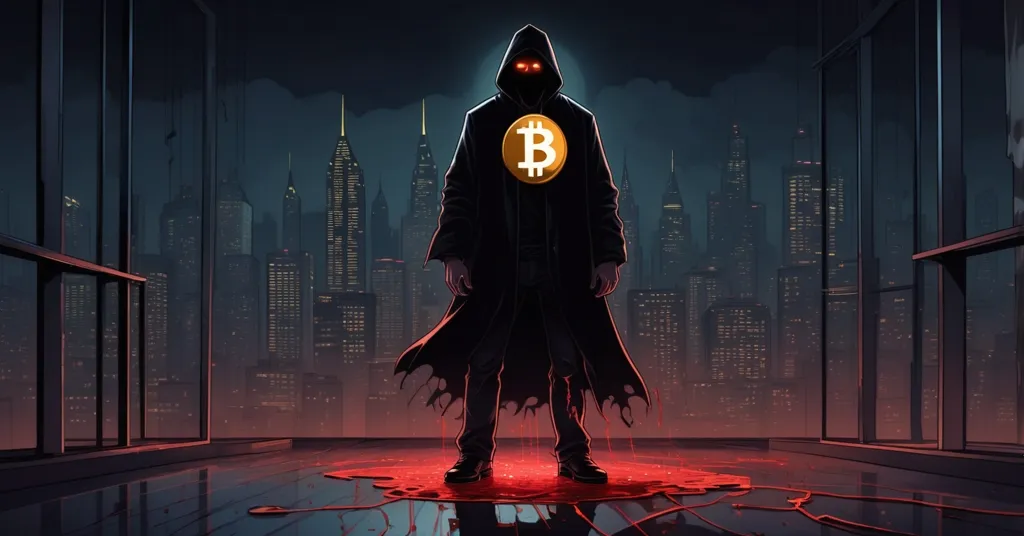Crypto Kidnapping Horror: Second Suspect Surrenders in Manhattan Bitcoin Torture Case

Crypto Kidnapping Nightmare: Second Suspect Surrenders in Manhattan Bitcoin Torture Plot
A gruesome crime has sent shockwaves through the crypto community as William Duplessie, the second suspect in a chilling Bitcoin-related kidnapping, surrendered to New York City police on May 27. Alongside John Woeltz, arrested days earlier, Duplessie is accused of luring a 28-year-old Italian man to Manhattan, only to subject him to weeks of horrific torture in a luxury SoHo apartment—all to seize control of his Bitcoin holdings. This case exposes the raw, dangerous underbelly of digital wealth and serves as a brutal wake-up call for anyone holding cryptocurrency.
- Second Suspect Caught: William Duplessie, 33, turned himself in, following John Woeltz’s arrest on Friday.
- Horrific Abuse: The victim was tortured for weeks, including electrocution and death threats, to access his Bitcoin.
- Critical Warning: This crime highlights the deadly risks of holding crypto and the urgent need for robust security.
The Crime: A Nightmare Unfolds in SoHo
The details of this incident are nothing short of a horror story. On May 6, the unidentified Italian victim was lured to New York City under false pretenses, only to be trapped in a high-end apartment on Prince Street in SoHo, with rental costs reportedly between $30,000 and $75,000 a month. For two weeks, he endured unimaginable cruelty at the hands of Duplessie and Woeltz. They allegedly bound him, shocked him by tasing him with his feet submerged in water, pistol-whipped him, cut him, threatened him with a firearm and an electric chainsaw, and even dangled him over a ledge as a terror tactic. Further reports reveal they forced him to take drugs like cocaine, tracked his movements with an AirTag, and took Polaroid photos of his torture—likely as leverage to extort his family. You can find more on such real-life crypto kidnapping stories to understand the growing dangers for Bitcoin holders.
The victim’s nightmare ended on a Friday morning when he seized a fleeting moment of distraction by his captors to escape. Stumbling into the street, he found a nearby traffic officer and pleaded for help. When police raided the apartment, they uncovered a scene of utter depravity: bloodstains, bullets, a gun, crack cocaine, broken glass, night vision goggles, bulletproof vests, and those haunting Polaroids. This wasn’t just a crime scene—it was a stark reminder of how far greed can drive people in the pursuit of digital gold.
The Culprits: From Crypto Insiders to Accused Criminals
Both suspects now face serious charges, including assault, kidnapping, holding the victim against his will, and criminal possession of a firearm. John Woeltz, once hailed as the “Kentucky king of crypto” with an estimated net worth of $100 million, was arrested on Friday, arraigned the next day with no bail, and forced to surrender his passport. His next court hearing is set for May 28. Woeltz’s public persona as a crypto heavyweight makes his alleged involvement all the more jarring—turns out, some crowns are forged in blood, not blockchain. For more on his background, check out recent updates on John Woeltz’s business dealings.
William Duplessie, a 33-year-old from Miami, surrendered at the 13th precinct at 7:45 a.m. on May 27. He’s listed as co-founder of Pangaea Digital Asset Fund, a Switzerland-based outfit focused on distressed blockchain firms. While details on the fund are scarce due to inaccessible records—a red flag in itself for an industry already plagued by opacity—his connection to crypto investment raises troubling questions about trust among so-called insiders. Learn more about his association with Pangaea Digital Asset Fund’s background. A third person, a female suspect, was arrested but not charged, leaving lingering mysteries about the full scope of this operation. Police claim Duplessie and Woeltz are business partners, though the nature of their relationship, and whether the victim was a mutual associate, remains unclear.
Amid the damning allegations, Woeltz’s family has come forward with a defense that’s hard to digest given the evidence. Speaking to The New York Post, a relative painted a different picture of the accused.
“He’s a kind, caring, loving person so he was completely controlled by other people.” – A relative of John Woeltz
Sure, it’s a claim worth noting, but let’s not kid ourselves—defenses like this pop up in almost every high-profile case. Without hard evidence of manipulation, and with a crime scene dripping with brutality, it’s a tough sell. Whether Woeltz was a pawn or a predator remains to be seen, but the burden of proof lies heavy on his side. For a broader perspective on this incident, see the detailed report on the Manhattan Bitcoin torture plot.
The Risks: Wrench Attacks and Bitcoin’s Dark Side
This case is a brutal reality check for crypto holders everywhere. Bitcoin offers financial freedom through decentralization, operating on a blockchain—a public ledger that records transactions without a middleman. You’re your own bank, controlling your wealth via private keys, those digital passwords unlocking your funds. But there’s no safety net. Unlike traditional accounts with institutional safeguards, if someone forcibly gets your keys—say, through a gun to your head—your wealth is gone. No customer service, no chargebacks, just a cold, hard loss.
In crypto lingo, this is a classic “wrench attack,” where physical violence, from home invasions to kidnappings, is used to coerce access to digital assets. It’s not a new phenomenon; as Bitcoin’s value has climbed, so have reports of such crimes, from Europe to South America. With whispers in the community of BTC potentially hitting $200,000 someday, the incentive for organized crime only grows. This Manhattan horror isn’t an outlier—it’s part of a grim trend targeting anyone perceived to hold significant crypto, especially if they’ve been careless enough to broadcast their stack on social media or elsewhere. For a deeper understanding, explore this explanation of wrench attacks and Bitcoin storage risks.
For newcomers, the lesson is stark: self-custody, where you personally secure your Bitcoin rather than leaving it on an exchange, is empowering but dangerous. Think of it as holding the only key to a vault—if someone tortures you for it, there’s no backup plan. Tools like hardware wallets (physical devices storing keys offline) and multi-signature setups (think of a safe needing two separate keys held by different people to open) are critical. Even splitting keys into parts using methods like Shamir’s Secret Sharing can add layers of protection. But tech alone isn’t enough; discretion—keeping your mouth shut about your holdings—is half the battle. To learn more about these dangers, check out this discussion on Bitcoin self-custody risks.
The Debate: Self-Custody vs. Centralized Solutions
Let’s flip the script for a moment and play devil’s advocate. If you’re new to Bitcoin and reading about this nightmare, you might ask: is self-custody worth the risk when stories like this surface? Some in the crypto space are murmuring about turning to custodians—third-party services that hold your assets, often with legal protections and insurance—as a safer bet for the less tech-savvy. It’s a bitter pill for Bitcoin maximalists like myself, who live by the mantra “not your keys, not your crypto,” but when a gun or a chainsaw enters the equation, the argument for a middle ground gets louder. Community insights on platforms like Reddit highlight growing concerns, as seen in discussions about self-custody fears and Bitcoin security trends.
Yet, here’s the rub: centralized custodians are the very beasts Bitcoin was born to slay. Handing over control means risking the same corruption, surveillance, and incompetence that plague traditional finance. It’s a philosophical deadlock—safety versus sovereignty—and there’s no tidy resolution. The Manhattan case might push some toward custodians, but for those of us hell-bent on disrupting the status quo, the fight for self-reliance, no matter the cost, remains non-negotiable. Still, we can’t ignore that not everyone’s ready to shoulder the burden of being their own bank.
The Fallout: Bitcoin’s Image and Legal Gray Areas
Beyond personal risk, this crime deals a blow to Bitcoin’s public image. Mainstream media loves a juicy “crypto crime” headline, often glossing over the fact that cash has fueled illicit deals for centuries. Bitcoin gets branded as the Wild West, a magnet for crooks, when the real villain is human greed, not the tech. If anything, blockchain’s transparency—every transaction traceable on a public ledger—can be a tool against crime if leveraged right. But sensational stories like this scare off potential adopters, especially when high-profile industry figures are the alleged perpetrators. Balanced education is our best defense, separating the promise of decentralization from the actions of bad actors. For community reactions, see this thread on Reddit about crypto kidnapping cases.
Then there’s the legal angle. Crypto-related crimes like wrench attacks sit in a murky space. Jurisdictions are still catching up, with few clear precedents for prosecuting physical coercion tied to digital assets. This case could set a benchmark, but it also exposes gaps—how do you protect holders when laws lag behind tech? The crypto community itself bears some responsibility too. Should we be louder in condemning figures like Woeltz and Duplessie, if proven guilty, to clean house? Or does that just feed the anti-Bitcoin narrative? It’s a tightrope walk between accountability and avoiding further PR damage. For tips on safeguarding against such threats, read up on preventing wrench attacks.
Even Duplessie’s tie to Pangaea Digital Asset Fund stinks of deeper issues. Distressed blockchain firms—the fund’s supposed focus—often involve messy, opaque dealings. Without accessible records, we’re left speculating, but the mere association with a crypto insider hints at eroded trust within the space. If scams and rug pulls (where developers hype a project, take the money, and vanish) weren’t enough, now we’ve got physical violence from supposed players. It’s a gut-wrenching reminder that not all disruptors are heroes—some are just wolves in hodler’s clothing.
Key Takeaways and Burning Questions
- What motivated Duplessie and Woeltz to target this Italian man for his Bitcoin?
While specifics are unclear, it’s likely the victim was a business associate or someone known to hold substantial Bitcoin, making him a prime target. Personal conflicts or failed deals could also be at play, pending further evidence. - How does this crime expose broader security risks for crypto holders?
It lays bare the threat of “wrench attacks,” where physical violence forces access to private keys, underscoring the vulnerability of self-custody without ironclad personal security and discretion. - Does Woeltz’s family claim of manipulation hold any water?
Their assertion that he was controlled by others introduces doubt, but without concrete proof, it’s overshadowed by the gruesome crime scene evidence. Investigations will need to dig deeper to validate this defense. - What impact might this case have on Bitcoin’s reputation?
It risks cementing Bitcoin as a criminal tool in public eyes, potentially deterring newcomers, unless countered by education that separates the technology’s potential from human malice. - How can the crypto community protect itself from similar attacks?
Emphasizing hardware wallets, multi-signature setups, and key-splitting methods, alongside staying silent about holdings and supporting community safety education, can reduce exposure to physical coercion. - Should centralized custodians be considered after such incidents?
While they offer safety with legal protections, they clash with Bitcoin’s ethos of decentralization. It’s a personal choice, but one that dilutes the fight for financial sovereignty many of us champion.
This Manhattan tragedy isn’t just a crime—it’s a mirror held up to the crypto world, reflecting both the stakes of our financial revolution and the predators lurking in its shadows. Bitcoin and blockchain carry the torch of freedom, privacy, and disruption, but damn, the path is fraught with peril. As champions of decentralization, we can’t shy away from the ugly truths. Instead, let’s use this horror as rocket fuel to accelerate better practices, smarter security, and louder education. If you’re shaken by this, it’s time to lock down your stack—start with the basics like a hardware wallet and a zipped lip. The promise of a new financial era is worth the fight, but only if we’re ready to face the wolves head-on.



